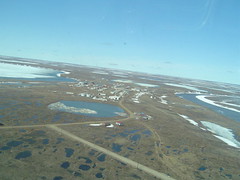There are, of course, some obvious associations between dogs and bugs. So, I know what you're probably thinking. But fleas and ticks have nothing to do with this arctic anomaly. No, this is something different and far more disturbing. This is about...mosquitoes. Being a transplant from the South, (the deep, deep South) I have experienced plenty of mosquitoes. I've slathered on bug dope and sprayed myself in the eyes (accidentally) more times than I can count. My senses are intimately acquainted with both the aroma and the flavor of Deep Woods Off. I've been bitten in every conceivable location of my body and have even slapped myself awake in the middle of the night (on more than one occasion) because some relentless mosquito couldn't resist my ear. I have real, tangible experience with mosquitoes. What I didn't understand right away is that Alaskan mosquitoes...tundra mosquitoes...are not the same.
Many southern states actually claim the mosquito as their unofficial state bird. Yes, I know they're kidding...sort of. I don't know if they all got together and made a uniform decision or if somebody came up with the idea and the others simply jumped on the bandwagon, but I've seen tourist shop merchandise in no less than five southern states, all claiming that the world's largest mosquitoes reside within their borders. I won't try to dispute their claims. I'm just saying...Alaskan mosquitoes are different. Alaskan mosquitoes don't just happen upon you. They hunt you down. They swarm you in a pack, hundreds at a time. They dig into your clothing and drill for blood. Wearing bug dope will keep them hovering a few inches from your skin, but it doesn't make them go away. It's like they know that the repellent will eventually wear off and they want to be there when it does. And they aren't content to just hang around. They will pelt you from every direction imaginable, so that it sounds like rain is hitting your hat or hood or jacket. I know it sounds like I'm exaggerating. I would think that too if I hadn't experienced it for myself. So, what does all this really have to do with The Buggy Side of the Dog? I'm getting there.
The one thing that sends Alaskan mosquitoes packing is a really stiff wind. Thankfully, we have a nice supply of that here on the tundra. I know there are some individuals who do not enjoy wind. It can be irritating, after all. Wind picks up sand and deposits it into your eyes, ears, nose, and your mouth if you haven't learned to keep it shut. In Atqasuk, wind is almost constant. There's really no question about whether the wind will blow, only from what direction and how hard. In the winter, when snow is blowing in my face at 45 or 50 mph during my half-mile walk to school, I will agree...wind is annoying. But, in the summer, wind can be a respite, a refuge, a blessing in disguise. If the wind is strong enough, the mosquitoes will hide down in the grass. If it's not quite windy enough for them to hide, even just a hefty breeze (at least 15 mph) will keep them behind you. That's why I coined the term "buggy side." It means just what it implies. If there is sufficient wind to challenge them, mosquitoes will hide...behind a person...or a dog...anything to stay aloft and near their potential smorgasbord.
While walking my dog one fine July afternoon, I noticed that the wind was not blowing hard enough to send the mosquitoes into the grass. I looked down at my dog, Rudy, walking ahead of me on his leash and was astounded by the sight of hundreds of mosquitoes clinging to his fur on the down-wind side of his body! It was as if an invisible line had been drawn straight down his spine and the mosquitoes dared not cross over! Of course, it was the windy side that was mosquito-free and the other side that was buggy. That got me thinking.
Wind has always fascinated me. I see a lot of symbolism in the creative and destructive power of a forceful wind. There is imagery there that I can appreciate and find meaningful. As I looked down at the buggy side of my poor dog, I thought about how extreme life often is. There's a buggy side to life that has nothing to do with mosquitoes. There are things in an average day that will suck you dry. A month, or even a few weeks, on the buggy side might be more than we feel we can bare at times and even the best repellent won't keep us safe for long. But then there's the wind. Irritating, sometimes. Dangerous, potentially. Blessed relief from the buggy side, always! Here's the important thing. There can only be a buggy side of the dog if there's a windy side to draw the line. That's what the image of my dog's ravaged fur means to me...the buggy side is real, but it's only half of the equation. The wind is just as real and it's much more powerful! I guess the trick is to find the wind and embrace it. Instead of hiding from its unpredictable nature...face it! Let the wind's forceful nature do its work, clearing away the bugs...the blood-suckers in our paths. My title, The Buggy Side of the Dog, isn't meant to focus on the negative elements in life, though I will acknowledge them. But I'd rather focus on the wind, that powerful positive, that keeps the "buggy" elements in life at bay.
So, that's where the title came from and that's what it means...at least to me.
Take a gander if you dare...

Remember, these are just the ones you can see!

Click on any photo to see more...











